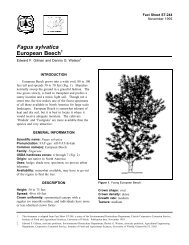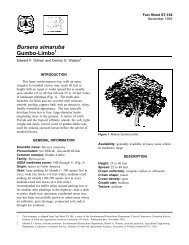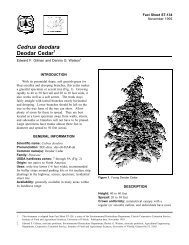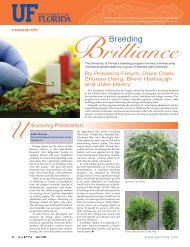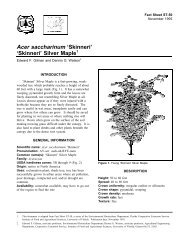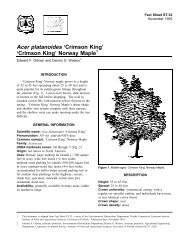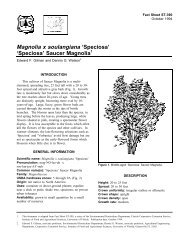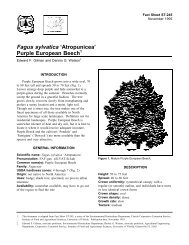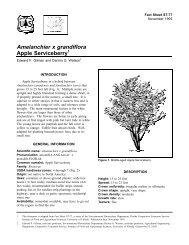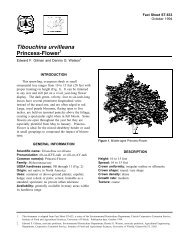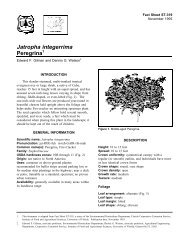Lagerstroemia x 'Tuscarora' 'Tuscarora' Crapemyrtle - Environmental ...
Lagerstroemia x 'Tuscarora' 'Tuscarora' Crapemyrtle - Environmental ...
Lagerstroemia x 'Tuscarora' 'Tuscarora' Crapemyrtle - Environmental ...
You also want an ePaper? Increase the reach of your titles
YUMPU automatically turns print PDFs into web optimized ePapers that Google loves.
<strong>Lagerstroemia</strong> x ‘Tuscarora’<br />
‘Tuscarora’ <strong>Crapemyrtle</strong> 1<br />
Edward F. Gilman and Dennis G. Watson 2<br />
INTRODUCTION<br />
A long period of striking flower color, attractive<br />
fall foliage, fabulous, exfoliating bark and good<br />
drought-tolerance all combine to make this Crape-<br />
Myrtle a favorite small tree for either formal or<br />
informal landscapes (Fig. 1). But this cultivar appears<br />
to be less cold hardy than some of the other mildewresistant<br />
selections. It is recommended for planting in<br />
urban areas.<br />
GENERAL INFORMATION<br />
Scientific name: <strong>Lagerstroemia</strong> x ‘Tuscarora’<br />
Pronunciation: lay-ger-STREE-mee-uh<br />
Common name(s): ‘Tuscarora’ <strong>Crapemyrtle</strong><br />
Family: Lythraceae<br />
USDA hardiness zones: 7 through 9A (Fig. 2)<br />
Origin: not native to North America<br />
Uses: container or above-ground planter; large<br />
parking lot islands (> 200 square feet in size); wide<br />
tree lawns (>6 feet wide); medium-sized parking lot<br />
islands (100-200 square feet in size); medium-sized<br />
tree lawns (4-6 feet wide); recommended for buffer<br />
strips around parking lots or for median strip plantings<br />
in the highway; near a deck or patio; trainable as a<br />
standard; small parking lot islands (< 100 square feet<br />
in size); narrow tree lawns (3-4 feet wide); specimen;<br />
residential street tree; tree has been successfully grown<br />
in urban areas where air pollution, poor drainage,<br />
compacted soil, and/or drought are common<br />
Availability: generally available in many areas within<br />
its hardiness range<br />
Figure 1. Young ‘Tuscarora’ <strong>Crapemyrtle</strong>.<br />
DESCRIPTION<br />
Fact Sheet ST-348<br />
November 1993<br />
Height: 18 to 25 feet<br />
Spread: 15 to 18 feet<br />
Crown uniformity: symmetrical canopy with a<br />
regular (or smooth) outline, and individuals have more<br />
or less identical crown forms<br />
Crown shape: vase shape<br />
Crown density: moderate<br />
Growth rate: medium<br />
Texture: medium<br />
1. This document is adapted from Fact Sheet ST-348, a series of the <strong>Environmental</strong> Horticulture Department, Florida Cooperative Extension Service,<br />
Institute of Food and Agricultural Sciences, University of Florida. Publication date: November 1993.<br />
2. Edward F. Gilman, associate professor, <strong>Environmental</strong> Horticulture Department; Dennis G. Watson, associate professor, Agricultural Engineering<br />
Department, Cooperative Extension Service, Institute of Food and Agricultural Sciences, University of Florida, Gainesville FL 32611.
<strong>Lagerstroemia</strong> x ‘Tuscarora’ -- ‘Tuscarora’ <strong>Crapemyrtle</strong> Page 2<br />
Figure 2. Shaded area represents potential planting range.<br />
Foliage<br />
Leaf arrangement: opposite/subopposite (Fig. 3)<br />
Leaf type: simple<br />
Leaf margin: entire<br />
Leaf shape: elliptic (oval); oblong; obovate<br />
Leaf venation: pinnate<br />
Leaf type and persistence: deciduous<br />
Leaf blade length: 2 to 4 inches; less than 2 inches<br />
Leaf color: green<br />
Fall color: orange; red; yellow<br />
Fall characteristic: showy<br />
Flower<br />
Flower color: red<br />
Flower characteristics: spring flowering; summer<br />
flowering; very showy<br />
Fruit<br />
Fruit shape: oval; round<br />
Fruit length: < .5 inch<br />
Fruit covering: dry or hard<br />
Fruit color: brown<br />
Fruit characteristics: does not attract wildlife; no<br />
significant litter problem; persistent on the tree; showy<br />
Trunk and Branches<br />
Trunk/bark/branches: bark is thin and easily<br />
damaged from mechanical impact; droop as the tree<br />
grows, and will require pruning for vehicular or<br />
pedestrian clearance beneath the canopy; routinely<br />
grown with, or trainable to be grown with, multiple<br />
trunks; showy trunk; tree wants to grow with several<br />
trunks but can be trained to grow with a single trunk;<br />
no thorns<br />
Pruning requirement: needs little pruning to develop<br />
a strong structure<br />
Breakage: resistant<br />
Current year twig color: brown; green<br />
Current year twig thickness: thin<br />
Culture<br />
Light requirement: tree grows in full sun<br />
Soil tolerances: clay; loam; sand; acidic; alkaline;<br />
well-drained<br />
Drought tolerance: high<br />
Aerosol salt tolerance: moderate
<strong>Lagerstroemia</strong> x ‘Tuscarora’ -- ‘Tuscarora’ <strong>Crapemyrtle</strong> Page 3<br />
Figure 3. Foliage of ‘Tuscarora’ <strong>Crapemyrtle</strong>.<br />
Other<br />
Roots: surface roots are usually not a problem<br />
Winter interest: tree has winter interest due to<br />
unusual form, nice persistent fruits, showy winter<br />
trunk, or winter flowers<br />
Outstanding tree: tree has outstanding ornamental<br />
features and could be planted more<br />
Invasive potential: little, if any, potential at this time<br />
Verticillium wilt susceptibility: not known to be<br />
susceptible<br />
Pest resistance: long-term health usually not<br />
affected by pests<br />
USE AND MANAGEMENT<br />
The 6- to 12-inch-long clustered coral pink blooms<br />
appear on the tips of branches during the summer.<br />
The individual flowers are ruffled and crinkly as to<br />
appear made of crepe paper. The smooth, peeling bark<br />
and multi-branched, open habit of Crape-Myrtle make<br />
it ideal for specimen planting where its bright red to<br />
orange-colored fall leaves add further interest. The<br />
tree is upright-spreading, or vase-shaped, with<br />
branches spreading out as they ascend. The tree<br />
probably grows 16 to 20 feet tall with a 15 to 18-foot<br />
spread. Lower branches droop as they grow older, and<br />
they will need to be removed to show off the bark and<br />
interesting trunk form.<br />
Pruning should be done in late winter or early in<br />
the spring before growth begins because it is easier to<br />
see which branches to prune. New growth can be<br />
pinched during the growing season to increase<br />
branchiness and flower number. Pruning methods vary<br />
from topping to cutting Crape-Myrtle nearly to the<br />
ground each spring to the removal of dead wood and<br />
old flower stalks only. Topping creates several long,<br />
thin branches from each cut which droop down under<br />
the weight of the flowers. This practice disfigures the<br />
nice trunk and branch structure. Lower branches are<br />
often thinned to show off the trunk form and color.<br />
You can remove the spent flower heads to encourage a<br />
second flush of flowers and to prevent formation of<br />
the brown fruits. Since cultivars are now available in<br />
a wide range of growth heights, severe pruning should<br />
not be necessary to control size. Severe pruning can<br />
stimulate basal sprouting which can become a constant<br />
nuisance, requiring regular removal. Some Crape-<br />
Myrtle trees sprout from the base of the trunk and<br />
roots even without severe heading.<br />
Crape-Myrtle grows best in full sun with rich,<br />
moist soil but will tolerate less hospitable positions in<br />
the landscape just as well, once it becomes established.<br />
It grows well in limited soil spaces in urban areas such<br />
as along boulevards, in parking lots, and in small<br />
pavement cutouts if provided with some irrigation.<br />
They tolerate clay and alkaline soil well. However,<br />
the flowers of some selections may stain car paint.<br />
Insect pests are few and ‘Tuscarora’ is resistant to<br />
powdery mildew. There are other new cultivars (many<br />
developed by the USDA) available which are resistant<br />
to powdery mildew.<br />
Many cultivars of Crape-Myrtle are available:<br />
hybrid ‘Acoma’, 14 to 16 feet tall, white flowers,<br />
purple-red fall foliage, mildew resistant; hybrid<br />
‘Biloxi’, 25 feet tall, pale pink blooms, orange-red fall<br />
foliage, hardy and mildew resistant; ‘Cherokee’, 10 to<br />
12 feet, bright red flowers; ‘Powhatan’, 14 to 20 feet,<br />
clear yellow fall foliage, medium purple flowers. The<br />
hybrid cultivars ‘Natchez’, 30 feet tall, pure white<br />
flowers, and ‘Muskogee’, 24 feet tall, light lavender<br />
flowers, are hybrids between <strong>Lagerstroemia</strong> indica and<br />
<strong>Lagerstroemia</strong> fauriei and have greater resistance to<br />
mildew. The cultivar ‘Crape Myrtlettes’ have the<br />
same color range as the species but only grow to three<br />
to four feet high. The National Arboretum releases are<br />
generally superior because they have been selected for<br />
their disease resistance. These releases may prove
<strong>Lagerstroemia</strong> x ‘Tuscarora’ -- ‘Tuscarora’ <strong>Crapemyrtle</strong> Page 4<br />
more resistant to powdery mildew in the Deep South,<br />
although further testing needs to be done to confirm<br />
this.<br />
Pests<br />
Propagation is by cuttings or seed.<br />
Aphids often infest the new growth causing an<br />
unsightly but harmless sooty mold to grow on the<br />
foliage. Heavy aphid infestations cause a heavy black<br />
sooty mold which detracts from the tree’s appearance.<br />
Diseases<br />
Powdery mildew can severely affect Crape-Myrtle<br />
but ‘Tuscarora’ is resistant.



